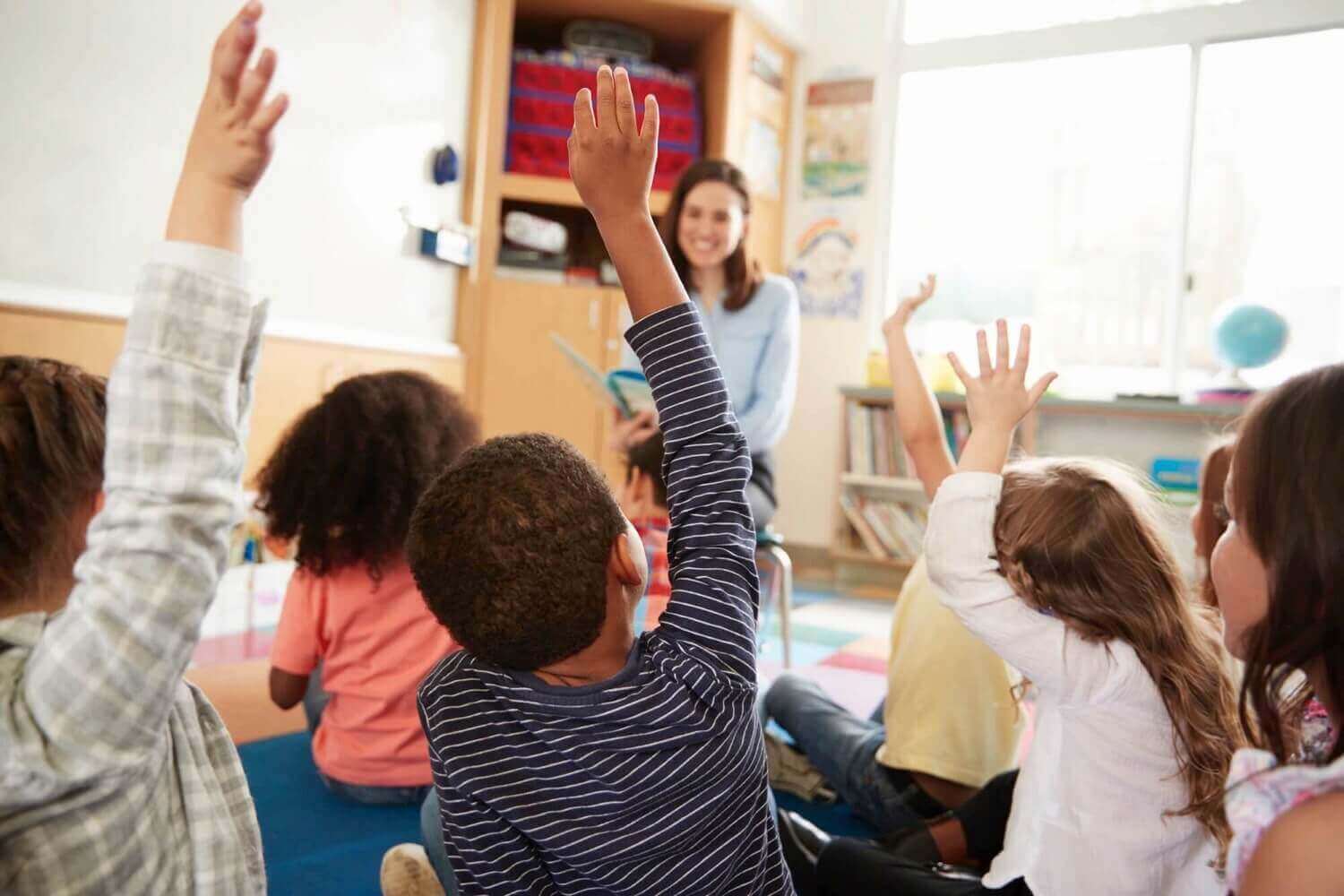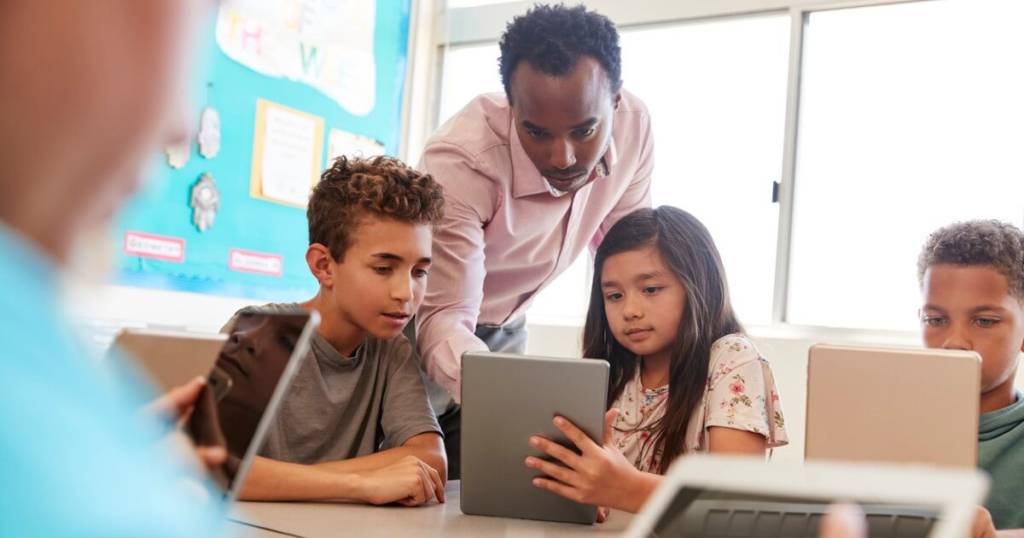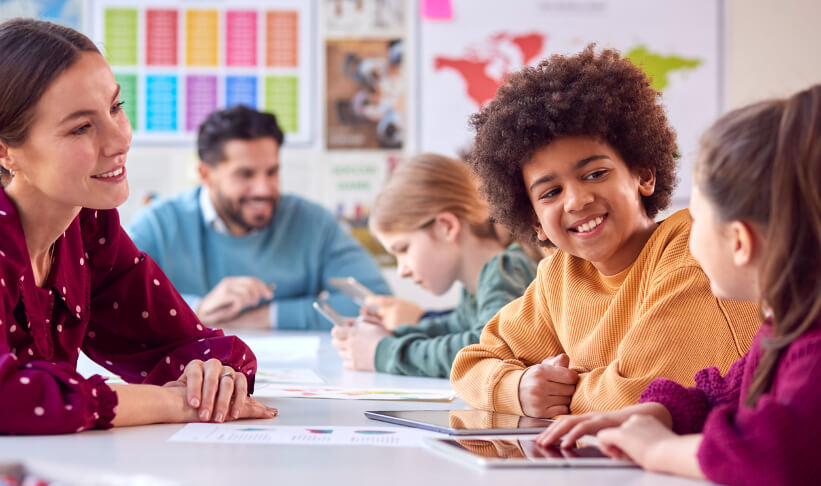Teachers know better than anyone that students each have their own unique gifts and challenges; interests, aptitudes and learning styles. Differentiated instruction is the practice of developing an understanding of how each student learns best, and then tailoring instruction to meet students’ individual needs.
“I think differentiated instruction actually is just teaching with the child in mind,” writes Carol Ann Tomlinson, an author and teacher regarded as a pioneer in differentiated instruction. She describes the practice as “a way of thinking about teaching which suggests that we establish very clear learning goals, that are very substantial, and then that we teach with an eye on the student.”
In her book, “How to Differentiate Instruction in Academically Diverse Classrooms,” she explains: “Kids of the same age aren’t all alike when it comes to learning any more than they are alike in terms of size, hobbies, personality, or food preferences. … In a classroom with little or no differentiated instruction, only student similarities seem to take center stage. In a differentiated classroom, commonalities are acknowledged and built upon, and student differences also become important elements in teaching and learning.”
At its most basic level, Tomlinson continues, “differentiating instruction means ‘shaking up’ what goes on in the classroom so that students have multiple options for taking in information, making sense of ideas, and expressing what they learn. In other words, a differentiated classroom provides different avenues to acquiring content, to processing or making sense of ideas, and to developing products so that each student can learn effectively.”
Tomlinson’s emphasis on “Content, Process and Product” is fundamental to the theory and practice of differentiated instruction.
History of Differentiated Instruction [From One-Room Schoolhouses to the 21st Century Classroom]
The one-room schoolhouses of centuries gone by are often mentioned when your research topic is “the history of differentiated instruction.” Though not called by that name, it was understood that teachers in the traditional one-room schoolhouse setting, out of necessity, had to develop strategies for teaching students of different ages, abilities, literacy levels and backgrounds.
“Today’s teachers still contend with the essential challenge of the teacher in the one-room schoolhouse: how to reach out effectively to students who span the spectrum of learning readiness, personal interests, and culturally shaped ways of seeing and speaking about and experiencing the world,” Tomlinson writes in another of her notable texts on the topic, “The Differentiated Classroom: Responding to the Needs of All Learners.”
The magazine Educational Leadership, established in 1943 by the Association for Supervision and Curriculum Development (ASCD), devoted an entire issue to the theme “The Challenge of Individual Difference” in 1953.
It invites readers to revisit the lead article by Carleton W. Washburne, “Adjusting the Program to the Child.” The report also cites the influence of Frederic Burk in the 1910s and other educators in recognizing the value of developing strategies for helping students “progress according to their own abilities.”
Some educational historians also draw connections between the No Child Left Behind Act of 2001, with its emphasis on helping disadvantaged students and improving individual outcomes in education, and some of the core principles of differentiated instruction.
Differentiated Instruction: Content, Process and Product
Today, differentiated instruction is widely practiced as a progressive approach to education that endeavors to leverage the unique learning characteristics each student brings to the classroom to deliver a more effective education than a so-called “one-size-fits-all” approach.
Reading Rockets, the Library of Congress Literacy Award-winning advocacy organization, also cites Tomlinson’s influence in mapping out the basic tenets of differentiated instruction, which guide classroom teachers in differentiating three specific aspects of the educational experience, plus a fourth that encompasses and expands upon these three:
- Content – the knowledge, concepts and skills that students need to learn based on the curriculum
- Process – the activities in which the student engages to understand and make sense of the content
- Products – the ways students demonstrate what they have come to know, understand and be able to do
Learning environment is the fourth variable in the differentiated instruction equation. It refers to the climate, or the look and feel of a classroom — the physical space as well as the tone set by the teacher to establish an atmosphere of mutually supportive learning.
A classroom with a learning environment optimized for differentiated instruction is one that:
- Establishes a safe and positive environment for learning
- Allows for individual work preferences
- Includes spaces to work quietly and without distraction as well as spaces that invite student collaboration
- Provides materials that reflect a variety of cultures and home settings
- Establishes clear guidelines for independent work that matches individual needs
- Helps students understand that some learners need to move around to learn while others do better sitting quietly
To help gauge the most effective strategies for reaching each student and helping them learn and perform to the best of their unique abilities, teachers are also encouraged to consider students’ individual:
- Readiness — This refers not as much to a student’s academic ability as to their capacity to learn new material in a particular subject or topic. Since one way to ensure learning growth is to challenge students with tasks that require them to stretch their minds, an awareness of student readiness can help teachers adjust the degree of difficulty to provide an appropriate level of challenge.
- Interest — Different students show interest in different topics and activities (from football to fashion to food, you name it). The basic theory here is that teachers can motivate students to learn by showing them how subjects being taught connect with their particular interests.
- Learning profile — The ways that students learn best can be shaped by a variety of factors including their culture, the learning environment (working solo or collaboratively, sitting still or moving around, in a quiet atmosphere or while listening to music), and their innate learning style or styles (for example, is the student a visual, auditory or kinesthetic learner?).
Differentiated Instruction: Classroom Strategies and Examples
A simplified example of connecting a student’s interest to the content of a particular learning goal or assignment is illustrated in an Education Week video narrated by teacher and author Larry Ferlazzo, who explains that differentiating instruction is really about getting to know your students and making decisions, often in the moment, based on what they need.
During a classroom assignment that involved an “argument essay” about what would be the worst natural disaster to experience, he noticed that one student had his head down on the desk and was not participating. Knowing that this student was interested in football, Ferlazzo engaged him to write his argument essay on the topic of “why his favorite team was the best.” In this case, the learning goal was developing the skills needed to make an effective argument (not learning about natural disasters) and the product was an essay that followed all the attributes of a good argument essay.
When it comes to process, the road to the best outcomes might involve teachers asking themselves: What are the learning objectives? And what are the best roads to get there for different students? A few of the possibilities include:
- Having students work alone or in groups
- Offering a choice on a variety of writing prompts
- Connecting subject matter to individual interests
- Employing tiered activities through which the whole class works on the same important subject matter and skills, but with different levels of support, challenge or complexity
Regarding product, Tomlinson has written, “students can propose the way they’d like to show us something, or we might offer them two choices — with the notion that they can make a deal with us to do the third one.”
Ferlazzo says that when he gave tests, he sometimes included an extra blank page for students to write (or write and draw!) “anything else they remember about the topic being tested that they think is important.” He found that sometimes those responses were more inspired than the responses to his test questions. Ferlazzo said his version of differentiated instruction did not require a significant amount of extra work, but “did require that I had relationships with my students to know their strengths, challenges and interests.”
Another example of a classroom that employs an interesting variation of differentiated instruction is seen in an Edutopia video titled “Station Rotation: Differentiating Instruction to Reach All Students.” At Highlander Charter School in Rhode Island, classes start with a group lesson then break into smaller groups, each of which rotates through three stations designed to connect students with the material using different learning modalities.
Pro & Cons of Differentiated Instruction
The biggest criticism around differentiated instruction often centers on the idea that it requires teachers to take on an even heavier workload. Here is a brief summary of some of the chief pros and cons.
Pros
- Research suggests that differentiated instruction can be effective both for students who are academic achievers as well as those with learning challenges or even significant disabilities.
- When offered more options on how they can learn the material, students become more motivated and engaged, taking on more responsibility for their own learning.
- When students are more engaged in learning, there are typically fewer classroom disciplinary problems.
Cons
- Many educators believe that making differentiated instruction truly worthwhile requires significant additional work devoted to lesson planning.
- Though differentiated instruction comes naturally to some educators, when practiced schoolwide there can be a significant learning curve and there are often insufficient professional development resources.
- Critics contend that there isn’t enough research to justify the additional resources required to support the benefits of differentiated instruction.
Differentiated Instruction FAQ
Innovative Techniques for Transforming Your Classroom
Many teachers reach a point in their career where they want to further develop their skills to make an even greater impact in their classroom, often following a particular passion or specific area of interest such as differentiated instruction. Whatever one’s desired area of focus, there are a range of master’s degree programs — including online options — designed to help working teachers achieve their career development goals.
For example, the University of San Diego offers an online Master of Education degree program with different specializations ranging from Inclusive Learning to Curriculum and Instruction. The curriculum in both specializations includes coursework focused on “strategies that provide differentiated support for the success of all students.”
Differentiated instruction is a comprehensive approach to teaching whose essence, according to the educational advocate Ferlazzo, is this: “Recognizing that all of our students bring different gifts and challenges, and that as educators we need to recognize those differences and use our professional judgment to flexibly respond to them in our teaching.”





